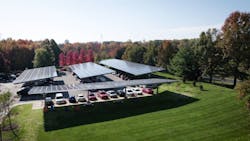Living Lab Demystifies the Challenges of Installing and Operating Microgrids
Siemens’ living lab in Princeton, N.J., aims to demystify the challenges of installing and operating microgrids and show potential microgrid adopters the path to a carbon-neutral future.
Paul Bennison, Siemens
The lab’s microgrid, located in the company’s US technology headquarters, has been operating for about a year and includes solar photovoltaics (PV), battery storage, electrical power infrastructure, building management systems and microgrid control systems. The microgrid also manages some controllable loads such as electric vehicle (EV) chargers.
Patent hub
Several hundred Siemens research workers are housed at the lab, and they often work with the Department of Energy, national laboratories and universities. The Siemens team produces about five US patents daily at the lab.
Construction of the lab’s microgrid began in 2019, and it allowed Siemens to test operating modes while the facility operated through Tropical Storm Isaias in 2020.
The lab facility’s team knew the storm was on its way and switched the microgrid into one of three available modes. In this case, the team chose “reliable mode” to ensure the battery’s state of charge was increased to maximum levels in the event of a utility outage, said Paul Bennison, business development manager for microgrids at Siemens during a video interview with Elisa Wood, editor-in-chief of Microgrid Knowledge.
The microgrid’s other modes include green mode —which prioritizes the use of renewable energy and refrains from using conventional resources — and economic mode, which focuses on dispatching the least expensive generating assets.
A forecasting capability helps the facility’s team optimize the renewable energy production and storage, improving asset dispatch for the current day and the two days after. With the forecasting ability, the team can make decisions about the microgrid operation based on the facility’s operating history.
Another feature of the microgrid is a cloud service that provides asset management. It allows the operations team to remotely evaluate alarms, faults and preventive maintenance, among other issues —displaying all this information on the same dashboard.
Reacts in milliseconds
Ultrafast uninterruptible power supply is an important feature of the microgrid. This utilizes the battery storage system to protect the site’s data center from undervoltage conditions, and it can be activated in less than 40 milliseconds after a power quality problem is recognized.
Also listen to Siemens’ Paul Bennison in this webinar on steps microgrid developers can take to develop microgrids easier, faster and cheaper.
“Forty milliseconds is effective in protecting sensitive electronic equipment for the majority of typical undervoltage conditions,” said Bennison. “We have a small data center, and we don’t even see the lights blink.”
Usually, to address power quality needs, a company would be required to purchase a dedicated uninterruptible power supply installation for its site.
In this case, the microgrid’s battery provides the uninterruptible power supply — and quickly.
“We use this when we’re having sags and swells of power and voltage issues and basically protecting sensitive electronic equipment,” said Bennison.
Visitors often ask why the microgrid’s battery storage system is set at 50% state of charge, rather than at 100%. This has to do with what happens when the facility suddenly loses a large load, such as a chiller. When this happens, the microgrid controller routes extra solar to charge the battery energy storage system. This means a portion of the battery storage capacity needs to be available to take that PV.
Microgrid enthusiasts who’d like to see the lab’s unique capabilities in action have a number of options, including a classic site visit and walk through the lab.
At the lab, visitors can learn how the electrons flow from solar panels to battery storage inverters and power distribution gear. They can also learn how building loads are controlled.
“They’re able to view and basically see how the system operates,” said Bennison.
Interactive tour of microgrid
The lab also hosts online visits and virtual workshops. Personnel can use an on-site microgrid simulator that simulates how the microgrid moves into island mode.
Learning about how microgrids work either virtually or via in-person visits to the lab can dispel myths about microgrids and give potential microgrid customers clear information about how they can green their companies.
“The microgrid system shows our existing customers and prospective customers a clear path forward to realize their own clean energy and carbon-neutral energy future. I think it’s a phenomenal demonstration,” said Bennison.








